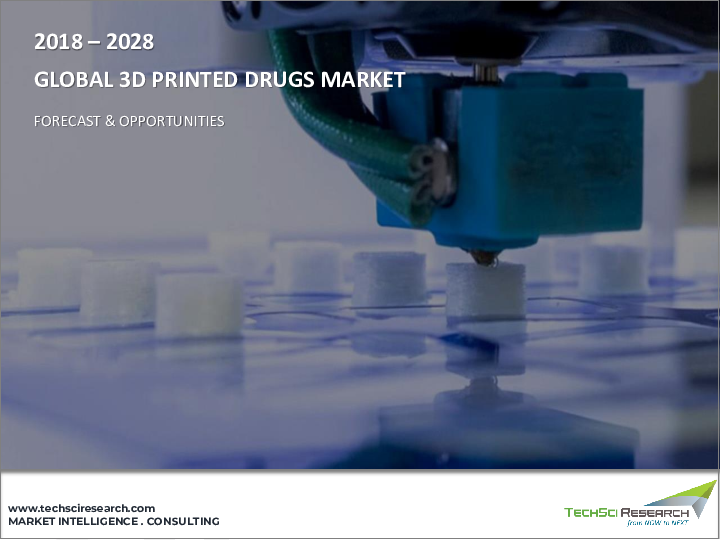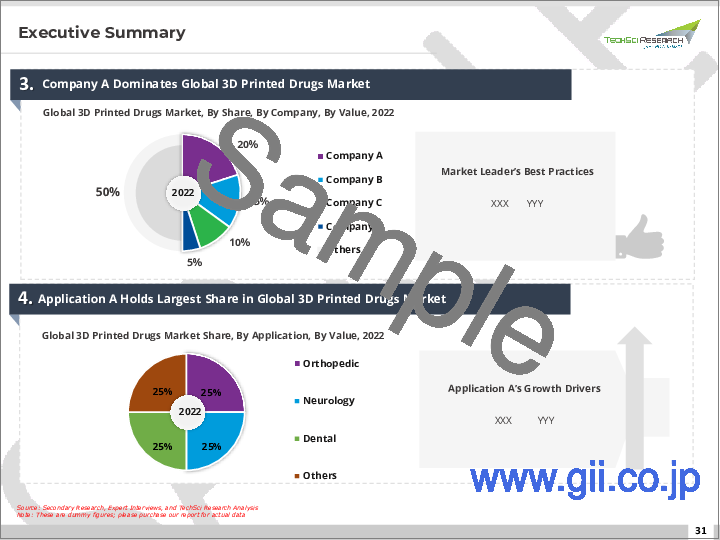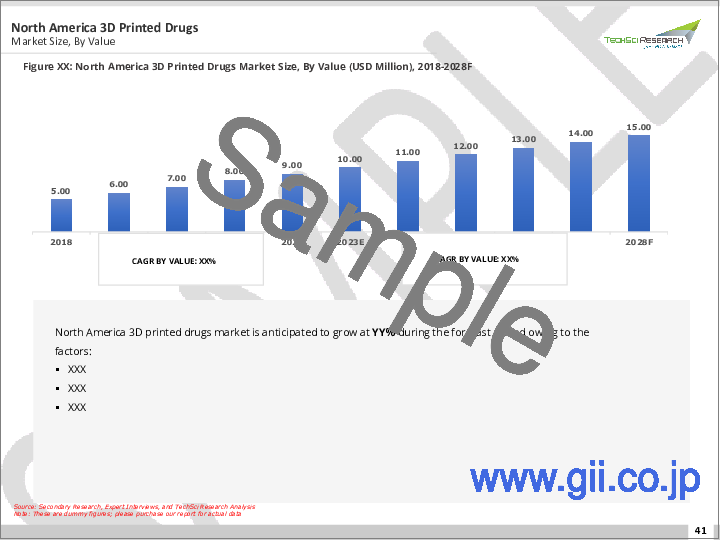|
|
市場調査レポート
商品コード
1171626
3Dプリント医薬品の世界市場 - 産業規模、シェア、動向、機会、予測:技術別、用途別、エンドユーザー別、地域別(2017年~2027年)3D Printed Drugs Market - Global Industry Size, Share, Trends, Opportunity, and Forecast, 2017-2027 Segmented by Technology, By Application, By End User, By Region |
||||||
|
● お客様のご希望に応じて、既存データの加工や未掲載情報(例:国別セグメント)の追加などの対応が可能です。 詳細はお問い合わせください。 |
|||||||
| 3Dプリント医薬品の世界市場 - 産業規模、シェア、動向、機会、予測:技術別、用途別、エンドユーザー別、地域別(2017年~2027年) |
|
出版日: 2022年12月01日
発行: TechSci Research
ページ情報: 英文 119 Pages
納期: 2~3営業日
|
- 全表示
- 概要
- 目次
世界の3Dプリント医薬品の市場規模は、予測期間中に目覚ましい成長を遂げると予測されています。
3Dプリント医薬品の使用に関する利点について、人々や患者の間で意識が高まっていることが、市場成長の要因となっています。また、嚥下障害を患う患者の増加も、今後数年間の市場成長を支えると期待されます。さらに、様々な病気に関連する新薬開発のための政府組織による投資増加、人々や医療従事者の間で3Dプリント医薬品の使用に関する意識が高まっていることが、予測期間中の市場成長をさらに押し上げ、個別化医療の人気の高まりが、市場成長に有利な機会を生み出す見込みです。
当レポートでは、世界の3Dプリント医薬品市場について調査分析し、セグメント別・地域別の市場規模・シェア予測、市場力学、企業プロファイルなど、体系的な情報を提供しています。
目次
第1章 製品概要
第2章 調査手法
第3章 エグゼクティブサマリー
第4章 世界の3Dプリント医薬品市場に対するCOVID-19の影響
第5章 VOC (顧客の声)
第6章 世界の3Dプリント医薬品市場の見通し
- 市場規模と予測
- 金額別
- 市場シェアと予測
- 技術別(インクジェット印刷、溶融堆積モデリング、光造形、ZipDose技術、その他)
- 用途別(整形外科、神経科、歯科、その他)
- エンドユーザー別(病院・クリニック、学術・研究機関、その他)
- 企業別(2021年)
- 地域別
- 市場マップ
第7章 北米の3Dプリント医薬品市場の見通し
- 市場規模と予測
- 金額別
- 市場シェアと予測
- 技術別
- 用途別
- エンドユーザー別
- 国別
- 国別分析
- 米国
- カナダ
- メキシコ
第8章 欧州の3Dプリント医薬品市場の見通し
- 市場規模と予測
- 金額別
- 市場シェアと予測
- 技術別
- 用途別
- エンドユーザー別
- 国別
- 国別分析
- フランス
- ドイツ
- 英国
- イタリア
- スペイン
第9章 アジア太平洋の3Dプリント医薬品市場の見通し
- 市場規模と予測
- 金額別
- 市場シェアと予測
- 技術別
- 用途別
- エンドユーザー別
- 国別
- 国別分析
- 中国
- インド
- 日本
- 韓国
- オーストラリア
第10章 南米の3Dプリント医薬品市場の見通し
- 市場規模と予測
- 金額別
- 市場シェアと予測
- 技術別
- 用途別
- エンドユーザー別
- 国別
- 国別分析
- ブラジル
- アルゼンチン
- コロンビア
第11章 中東・アフリカの3Dプリント医薬品市場の見通し
- 市場規模と予測
- 金額別
- 市場シェアと予測
- 技術別
- 用途別
- エンドユーザー別
- 国別
- 国別分析
- 南アフリカ
- サウジアラビア
- アラブ首長国連邦
- トルコ
- エジプト
第12章 市場力学
- 促進要因
- 課題
第13章 市場の動向と開発
第14章 競合情勢
- Aprecia Pharmaceuticals, LLC.
- FabRx Ltd.
- Merck & Co. Inc.
- Triastek, Inc.
- GlaxoSmithKline plc.
- Formac Pharmaceuticals N.V.
- AstraZeneca plc
- Extend Biosciences, Inc.
- Affinity Therapeutics, LLC
- Osmotica Pharmaceuticals Corporation
第15章 戦略的提言
The global 3d printed drugs market is anticipated to witness an impressive growth during the forecast period. This can be ascribed to increasing awareness amongst people and patients regarding the benefits associated with the usage of 3D printed drugs. Besides increasing number of patients suffering from dysphagia is expected to support the market growth in the coming years. Dysphagia is characterized by difficulty in swallowing. In this disease, it takes more time and effort to move food or liquid from mouth to stomach. 3D printed drugs are drugs created by 3D printing technology that are used to treat patients suffering from dysphagia. 3D printed drugs have a porous structure that can rapidly disintegrate in the mouth. Besides, increasing investments by government organizations for inventing new drugs related to different diseases couples with growing awareness regarding usage of 3D printed drugs among people and healthcare providers will further boost the market growth in the forecast period. Furthermore, growing popularity of personalized medicine is further expected to create lucrative opportunities for the market growth.
Increasing Prevalence of Chronic Diseases
The growing prevalence of chronic diseases such as diabetes, cancer, cardiovascular diseases, renal problems, among others across the globe is expected to create lucrative opportunities for the growth of global 3D printed drugs market. According to global cancer observatory, around 19,292,789 new cancer cases were reported worldwide in 2020, with breast cancer, lung cancer, colorectum cancer, prostate cancer and stomach cancer being the most prevalent types. This in turn is expected to increase the demand for 3D printed drugs for the treatment of different types of cancers. Additionally, growing geriatric population across the globe which is susceptible to various diseases requires medications that are not only effective but also affordable, thereby fuelling the growth of global 3D printed drugs market.
Benefits Associated With 3D Printed Drugs
There are numerous benefits associated with the use of 3D Printed Drugs such as using this technique medicines can be produced in small batches with carefully tailored shapes, dosages, and sizes, among others. In addition, the use of 3D printing technology can significantly reduce manufacturing costs. This in turn is expected to increase investments in this space, thereby supporting the market growth during the forecast period. However, increased awareness of the benefits of these medications, such as their immediate solubility, faster manufacturing time, reduced waste, and easy on-demand manufacturing is likely to create multiple prospects for market growth.
Market Segmentation
The Global 3D Printed Drugs market can be segmented by technology, by application, by end user, and by region. Based on technology, the market can be categorized into inkjet printing, fused deposition modeling, stereolithography, zipdose technology, and others. Based on application, the market can be fragmented into orthopedic, neurology, dental, and others. Based on end user, the market can be grouped into hospitals & clincs, academic & research institutions, and others. Regionally, North America dominated the market among Europe, Asia Pacific, Middle East & Africa, and South America. Among the different countries, United States dominated the Global 3D Printed Drugs Market on account of growing adoption, use and availability of personalized medicines in the United States. The number of personalized medicines available in the United States in 2020 were around 286.
Market Players
Aprecia Pharmaceuticals, LLC., FabRx Ltd., Merck & Co. Inc., Triastek, Inc., GlaxoSmithKline plc., Formac Pharmaceuticals N.V., AstraZeneca plc, Extend Biosciences, Inc., Affinity Therapeutics, LLC, Osmotica Pharmaceuticals Corporation are some of the leading players operating in the Global 3D Printed Drugs Market.
Report Scope
In this report, Global 3D Printed Drugs Market has been segmented into following categories, in addition to the industry trends which have also been detailed below:
3D Printed Drugs Market, By Technology:
- Inkjet Printing
- Fused Deposition Modeling
- Stereolithography
- Zip Dose Technology
- Others
3D Printed Drugs Market, By Application:
- Orthopedic
- Neurology
- Dental
- Others
3D Printed Drugs Market, By End User:
- Hospital & Clinics
- Academic & Research Institutions
- Others
3D Printed Drugs Market, By Region:
- North America
- United States
- Canada
- Mexico
- Europe
- France
- Germany
- United Kingdom
- Italy
- Spain
- Asia Pacific
- China
- India
- Japan
- South Korea
- Australia
- South America
- Brazil
- Argentina
- Colombia
- Middle East & Africa
- South Africa
- Saudi Arabia
- UAE
- Turkey
- Egypt
Competitive Landscape
Company Profiles: Detailed analysis of the major companies present in Global 3D Printed Drugs Market.
Available Customizations
With the given market data, TechSci Research offers customizations according to a company's specific needs. The following customization options are available for the report:
Company Information
- Detailed analysis and profiling of additional market players (up to five).
Table of Contents
1. Product Overview
2. Research Methodology
3. Executive Summary
4. Impact of COVID-19 on Global 3D Printed Drugs Market
5. Voice of Customer
6. Global 3D Printed Drugs Market Outlook
- 6.1. Market Size & Forecast
- 6.1.1. By Value
- 6.2. Market Share & Forecast
- 6.2.1. By Technology (Inkjet Printing, Fused Deposition Modeling, Stereolithography, ZipDose Technology, Others)
- 6.2.2. By Application (Orthopedic, Neurology, Dental, Others)
- 6.2.3. By End User (Hospitals & Clincs, Academic & Research Institutions, Others)
- 6.2.4. By Company (2021)
- 6.2.5. By Region
- 6.3. Market Map
7. North America 3D Printed Drugs Market Outlook
- 7.1. Market Size & Forecast
- 7.1.1. By Value
- 7.2. Market Share & Forecast
- 7.2.1. By Technology
- 7.2.2. By Application
- 7.2.3. By End User
- 7.2.4. By Country
- 7.3. North America: Country Analysis
- 7.3.1. United States 3D Printed Drugs Market Outlook
- 7.3.1.1. Market Size & Forecast
- 7.3.1.1.1. By Value
- 7.3.1.2. Market Share & Forecast
- 7.3.1.2.1. By Technology
- 7.3.1.2.2. By Application
- 7.3.1.2.3. By End User
- 7.3.1.1. Market Size & Forecast
- 7.3.2. Canada 3D Printed Drugs Market Outlook
- 7.3.2.1. Market Size & Forecast
- 7.3.2.1.1. By Value
- 7.3.2.2. Market Share & Forecast
- 7.3.2.2.1. By Technology
- 7.3.2.2.2. By Application
- 7.3.2.2.3. By End User
- 7.3.2.1. Market Size & Forecast
- 7.3.3. Mexico 3D Printed Drugs Market Outlook
- 7.3.3.1. Market Size & Forecast
- 7.3.3.1.1. By Value
- 7.3.3.2. Market Share & Forecast
- 7.3.3.2.1. By Technology
- 7.3.3.2.2. By Application
- 7.3.3.2.3. By End User
- 7.3.3.1. Market Size & Forecast
- 7.3.1. United States 3D Printed Drugs Market Outlook
8. Europe 3D Printed Drugs Market Outlook
- 8.1. Market Size & Forecast
- 8.1.1. By Value
- 8.2. Market Share & Forecast
- 8.2.1. By Technology
- 8.2.2. By Application
- 8.2.3. By End User
- 8.2.4. By Country
- 8.3. Europe: Country Analysis
- 8.3.1. France 3D Printed Drugs Market Outlook
- 8.3.1.1. Market Size & Forecast
- 8.3.1.1.1. By Value
- 8.3.1.2. Market Share & Forecast
- 8.3.1.2.1. By Technology
- 8.3.1.2.2. By Application
- 8.3.1.2.3. By End User
- 8.3.1.1. Market Size & Forecast
- 8.3.2. Germany 3D Printed Drugs Market Outlook
- 8.3.2.1. Market Size & Forecast
- 8.3.2.1.1. By Value
- 8.3.2.2. Market Share & Forecast
- 8.3.2.2.1. By Technology
- 8.3.2.2.2. By Application
- 8.3.2.2.3. By End User
- 8.3.2.1. Market Size & Forecast
- 8.3.3. United Kingdom 3D Printed Drugs Market Outlook
- 8.3.3.1. Market Size & Forecast
- 8.3.3.1.1. By Value
- 8.3.3.2. Market Share & Forecast
- 8.3.3.2.1. By Technology
- 8.3.3.2.2. By Application
- 8.3.3.2.3. By End User
- 8.3.3.1. Market Size & Forecast
- 8.3.4. Italy 3D Printed Drugs Market Outlook
- 8.3.4.1. Market Size & Forecast
- 8.3.4.1.1. By Value
- 8.3.4.2. Market Share & Forecast
- 8.3.4.2.1. By Technology
- 8.3.4.2.2. By Application
- 8.3.4.2.3. By End User
- 8.3.4.1. Market Size & Forecast
- 8.3.5. Spain 3D Printed Drugs Market Outlook
- 8.3.5.1. Market Size & Forecast
- 8.3.5.1.1. By Value
- 8.3.5.2. Market Share & Forecast
- 8.3.5.2.1. By Technology
- 8.3.5.2.2. By Application
- 8.3.5.2.3. By End User
- 8.3.5.1. Market Size & Forecast
- 8.3.1. France 3D Printed Drugs Market Outlook
9. Asia-Pacific 3D Printed Drugs Market Outlook
- 9.1. Market Size & Forecast
- 9.1.1. By Value
- 9.2. Market Share & Forecast
- 9.2.1. By Technology
- 9.2.2. By Application
- 9.2.3. By End User
- 9.2.4. By Country
- 9.3. Asia-Pacific: Country Analysis
- 9.3.1. China 3D Printed Drugs Market Outlook
- 9.3.1.1. Market Size & Forecast
- 9.3.1.1.1. By Value
- 9.3.1.2. Market Share & Forecast
- 9.3.1.2.1. By Technology
- 9.3.1.2.2. By Application
- 9.3.1.2.3. By End User
- 9.3.1.1. Market Size & Forecast
- 9.3.2. India 3D Printed Drugs Market Outlook
- 9.3.2.1. Market Size & Forecast
- 9.3.2.1.1. By Value
- 9.3.2.2. Market Share & Forecast
- 9.3.2.2.1. By Technology
- 9.3.2.2.2. By Application
- 9.3.2.2.3. By End User
- 9.3.2.1. Market Size & Forecast
- 9.3.3. Japan 3D Printed Drugs Market Outlook
- 9.3.3.1. Market Size & Forecast
- 9.3.3.1.1. By Value
- 9.3.3.2. Market Share & Forecast
- 9.3.3.2.1. By Technology
- 9.3.3.2.2. By Application
- 9.3.3.2.3. By End User
- 9.3.3.1. Market Size & Forecast
- 9.3.4. South Korea 3D Printed Drugs Market Outlook
- 9.3.4.1. Market Size & Forecast
- 9.3.4.1.1. By Value
- 9.3.4.2. Market Share & Forecast
- 9.3.4.2.1. By Technology
- 9.3.4.2.2. By Application
- 9.3.4.2.3. By End User
- 9.3.4.1. Market Size & Forecast
- 9.3.5. Australia 3D Printed Drugs Market Outlook
- 9.3.5.1. Market Size & Forecast
- 9.3.5.1.1. By Value
- 9.3.5.2. Market Share & Forecast
- 9.3.5.2.1. By Technology
- 9.3.5.2.2. By Application
- 9.3.5.2.3. By End User
- 9.3.5.1. Market Size & Forecast
- 9.3.1. China 3D Printed Drugs Market Outlook
10. South America 3D Printed Drugs Market Outlook
- 10.1. Market Size & Forecast
- 10.1.1. By Value
- 10.2. Market Share & Forecast
- 10.2.1. By Technology
- 10.2.2. By Application
- 10.2.3. By End User
- 10.2.4. By Country
- 10.3. South America: Country Analysis
- 10.3.1. Brazil 3D Printed Drugs Market Outlook
- 10.3.1.1. Market Size & Forecast
- 10.3.1.1.1. By Value
- 10.3.1.2. Market Share & Forecast
- 10.3.1.2.1. By Technology
- 10.3.1.2.2. By Application
- 10.3.1.2.3. By End User
- 10.3.1.1. Market Size & Forecast
- 10.3.2. Argentina 3D Printed Drugs Market Outlook
- 10.3.2.1. Market Size & Forecast
- 10.3.2.1.1. By Value
- 10.3.2.2. Market Share & Forecast
- 10.3.2.2.1. By Technology
- 10.3.2.2.2. By Application
- 10.3.2.2.3. By End User
- 10.3.2.1. Market Size & Forecast
- 10.3.3. Colombia 3D Printed Drugs Market Outlook
- 10.3.3.1. Market Size & Forecast
- 10.3.3.1.1. By Value
- 10.3.3.2. Market Share & Forecast
- 10.3.3.2.1. By Technology
- 10.3.3.2.2. By Application
- 10.3.3.2.3. By End User
- 10.3.3.1. Market Size & Forecast
- 10.3.1. Brazil 3D Printed Drugs Market Outlook
11. Middle East and Africa 3D Printed Drugs Market Outlook
- 11.1. Market Size & Forecast
- 11.1.1. By Value
- 11.2. Market Share & Forecast
- 11.2.1. By Technology
- 11.2.2. By Application
- 11.2.3. By End User
- 11.2.4. By Country
- 11.3. MEA: Country Analysis
- 11.3.1. South Africa 3D Printed Drugs Market Outlook
- 11.3.1.1. Market Size & Forecast
- 11.3.1.1.1. By Value
- 11.3.1.2. Market Share & Forecast
- 11.3.1.2.1. By Technology
- 11.3.1.2.2. By Application
- 11.3.1.2.3. By End User
- 11.3.1.1. Market Size & Forecast
- 11.3.2. Saudi Arabia 3D Printed Drugs Market Outlook
- 11.3.2.1. Market Size & Forecast
- 11.3.2.1.1. By Value
- 11.3.2.2. Market Share & Forecast
- 11.3.2.2.1. By Technology
- 11.3.2.2.2. By Application
- 11.3.2.2.3. By End User
- 11.3.2.1. Market Size & Forecast
- 11.3.3. UAE 3D Printed Drugs Market Outlook
- 11.3.3.1. Market Size & Forecast
- 11.3.3.1.1. By Value
- 11.3.3.2. Market Share & Forecast
- 11.3.3.2.1. By Technology
- 11.3.3.2.2. By Application
- 11.3.3.2.3. By End User
- 11.3.3.1. Market Size & Forecast
- 11.3.4. Turkey 3D Printed Drugs Market Outlook
- 11.3.4.1. Market Size & Forecast
- 11.3.4.1.1. By Value
- 11.3.4.2. Market Share & Forecast
- 11.3.4.2.1. By Technology
- 11.3.4.2.2. By Application
- 11.3.4.2.3. By End User
- 11.3.4.1. Market Size & Forecast
- 11.3.5. Egypt 3D Printed Drugs Market Outlook
- 11.3.5.1. Market Size & Forecast
- 11.3.5.1.1. By Value
- 11.3.5.2. Market Share & Forecast
- 11.3.5.2.1. By Technology
- 11.3.5.2.2. By Application
- 11.3.5.2.3. By End User
- 11.3.5.1. Market Size & Forecast
- 11.3.1. South Africa 3D Printed Drugs Market Outlook
12. Market Dynamics
- 12.1. Drivers
- 12.2. Challenges
13. Market Trends & Developments
14. Competitive Landscape
- 14.1. Aprecia Pharmaceuticals, LLC.
- 14.2. FabRx Ltd.
- 14.3. Merck & Co. Inc.
- 14.4. Triastek, Inc.
- 14.5. GlaxoSmithKline plc.
- 14.6. Formac Pharmaceuticals N.V.
- 14.7. AstraZeneca plc
- 14.8. Extend Biosciences, Inc.
- 14.9. Affinity Therapeutics, LLC
- 14.10. Osmotica Pharmaceuticals Corporation




